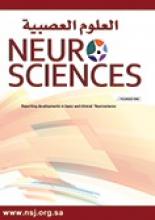Research ArticleOriginal Article
Open Access
Cultural acceptance of robotic telestroke medicine among patients and healthcare providers in Saudi Arabia
Results of a pilot study
Ali M. Al-Khathaami, Saeed M. Alshahrani, Suleiman M. Kojan, Mohammed A. Al-Jumah, Ahmed A. Alamry and Ashraf A. El-Metwally
Neurosciences Journal January 2015, 20 (1) 27-30;
Ali M. Al-Khathaami
From the Departments of Neurology (Al-Khathaami, Kojan, Al-Jumah), and Emergency Medicine (Alamry), King Abdulaziz Medical City, National Guard Health Affairs, the Department of Epidemiology & Biostatistics (Al-Khathaami, Alshahrani, El-Metwally), College of Public Health and Health Informatics, King Saud Bin Abdulaziz University for Health Sciences, the King Abdullah International Medical Research Center (Al-Jumah, El-Metwally), Riyadh, Kingdom of Saudi Arabia, and the Epidemiology Group (El-Metwally), Institute of Applied Health Sciences, University of Aberdeen, Aberdeen, Scotland, United Kingdom
MPH, FRCPCSaeed M. Alshahrani
From the Departments of Neurology (Al-Khathaami, Kojan, Al-Jumah), and Emergency Medicine (Alamry), King Abdulaziz Medical City, National Guard Health Affairs, the Department of Epidemiology & Biostatistics (Al-Khathaami, Alshahrani, El-Metwally), College of Public Health and Health Informatics, King Saud Bin Abdulaziz University for Health Sciences, the King Abdullah International Medical Research Center (Al-Jumah, El-Metwally), Riyadh, Kingdom of Saudi Arabia, and the Epidemiology Group (El-Metwally), Institute of Applied Health Sciences, University of Aberdeen, Aberdeen, Scotland, United Kingdom
BSc, MPHSuleiman M. Kojan
From the Departments of Neurology (Al-Khathaami, Kojan, Al-Jumah), and Emergency Medicine (Alamry), King Abdulaziz Medical City, National Guard Health Affairs, the Department of Epidemiology & Biostatistics (Al-Khathaami, Alshahrani, El-Metwally), College of Public Health and Health Informatics, King Saud Bin Abdulaziz University for Health Sciences, the King Abdullah International Medical Research Center (Al-Jumah, El-Metwally), Riyadh, Kingdom of Saudi Arabia, and the Epidemiology Group (El-Metwally), Institute of Applied Health Sciences, University of Aberdeen, Aberdeen, Scotland, United Kingdom
MD, FACPMohammed A. Al-Jumah
From the Departments of Neurology (Al-Khathaami, Kojan, Al-Jumah), and Emergency Medicine (Alamry), King Abdulaziz Medical City, National Guard Health Affairs, the Department of Epidemiology & Biostatistics (Al-Khathaami, Alshahrani, El-Metwally), College of Public Health and Health Informatics, King Saud Bin Abdulaziz University for Health Sciences, the King Abdullah International Medical Research Center (Al-Jumah, El-Metwally), Riyadh, Kingdom of Saudi Arabia, and the Epidemiology Group (El-Metwally), Institute of Applied Health Sciences, University of Aberdeen, Aberdeen, Scotland, United Kingdom
MBBS, FRCPCAhmed A. Alamry
From the Departments of Neurology (Al-Khathaami, Kojan, Al-Jumah), and Emergency Medicine (Alamry), King Abdulaziz Medical City, National Guard Health Affairs, the Department of Epidemiology & Biostatistics (Al-Khathaami, Alshahrani, El-Metwally), College of Public Health and Health Informatics, King Saud Bin Abdulaziz University for Health Sciences, the King Abdullah International Medical Research Center (Al-Jumah, El-Metwally), Riyadh, Kingdom of Saudi Arabia, and the Epidemiology Group (El-Metwally), Institute of Applied Health Sciences, University of Aberdeen, Aberdeen, Scotland, United Kingdom
MHA, FRCPCAshraf A. El-Metwally
From the Departments of Neurology (Al-Khathaami, Kojan, Al-Jumah), and Emergency Medicine (Alamry), King Abdulaziz Medical City, National Guard Health Affairs, the Department of Epidemiology & Biostatistics (Al-Khathaami, Alshahrani, El-Metwally), College of Public Health and Health Informatics, King Saud Bin Abdulaziz University for Health Sciences, the King Abdullah International Medical Research Center (Al-Jumah, El-Metwally), Riyadh, Kingdom of Saudi Arabia, and the Epidemiology Group (El-Metwally), Institute of Applied Health Sciences, University of Aberdeen, Aberdeen, Scotland, United Kingdom
MD, PhD
References
- ↵
- Saver JL,
- Fonarow GC,
- Smith EE,
- Reeves MJ,
- Grau-Sepulveda MV,
- Pan W,
- et al.
- ↵
- Hakim AM
- ↵
- Hirsch JA,
- Yoo AJ,
- Nogueira RG,
- Verduzco LA,
- Schwamm LH,
- Pryor JC,
- et al.
- ↵
- Broderick JP
- ↵
- Audebert HJ,
- Schenkel J,
- Heuschmann PU,
- Bogdahn U,
- Haberl RL,
- Telemedic Pilot Project for Integrative Stroke Care Group
- ↵
- Schwamm LH,
- Holloway RG,
- Amarenco P,
- Audebert HJ,
- Bakas T,
- Chumbler NR,
- et al.
- ↵
- LaMonte MP,
- Xiao Y,
- Hu PF,
- Gagliano DM,
- Bahouth MN,
- Gunawardane RD,
- et al.
- ↵
- Murphy SL,
- XU J,
- Kochanek KD
- ↵
- Al Khathaami AM,
- Algahtani H,
- Alwabel A,
- Alosherey N,
- Kojan S,
- Aljumah M
- ↵
- Hess DC,
- Wang S,
- Gross H,
- Nichols FT,
- Hall CE,
- Adams RJ
- ↵
- Ickenstein GW,
- Horn M,
- Schenkel J,
- Vatankhah B,
- Bogdahn U,
- Haberl R,
- et al.
- ↵
- Audebert HJ,
- Kukla C,
- Vatankhah B,
- Gotzler B,
- Schenkel J,
- Hofer S,
- et al.
- ↵
- Rogove HJ,
- McArthur D,
- Demaerschalk BM,
- Vespa PM
- ↵
- Broadbent E,
- Kuo IH,
- Lee YI,
- Rabindran J,
- Kerse N,
- Stafford R,
- et al.
- ↵
- Mendez I,
- Jong M,
- Keays-White D,
- Turner G
In this issue
Cultural acceptance of robotic telestroke medicine among patients and healthcare providers in Saudi Arabia
Ali M. Al-Khathaami, Saeed M. Alshahrani, Suleiman M. Kojan, Mohammed A. Al-Jumah, Ahmed A. Alamry, Ashraf A. El-Metwally
Neurosciences Journal Jan 2015, 20 (1) 27-30;
Jump to section
Related Articles
- No related articles found.
Cited By...
- No citing articles found.





